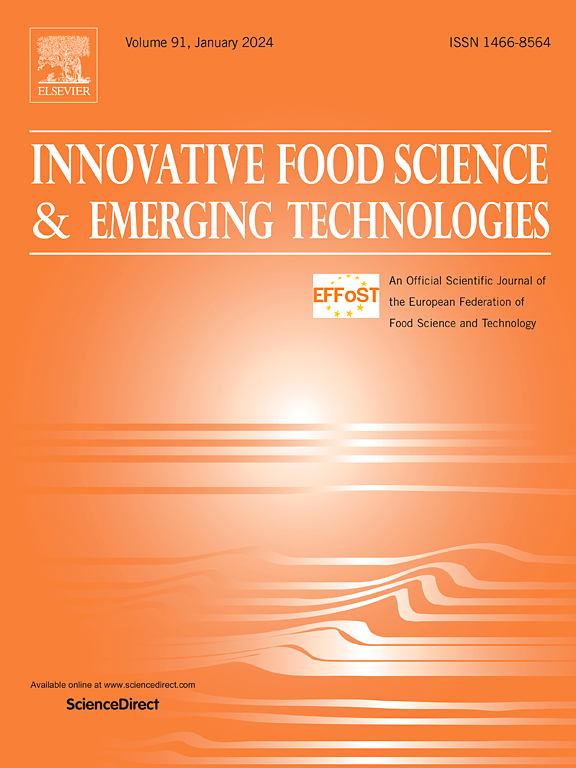利用离子液体磁性吸附剂从乳清中捕获乳清蛋白
IF 6.3
1区 农林科学
Q1 FOOD SCIENCE & TECHNOLOGY
Innovative Food Science & Emerging Technologies
Pub Date : 2024-12-30
DOI:10.1016/j.ifset.2024.103914
引用次数: 0
摘要
乳清蛋白是生物活性肽的重要来源,具有抗氧化、降压、抗菌等作用。事实上,乳清蛋白具有重要的营养价值,包括潜在的免疫和抗病毒作用。然而,为了设计目标应用的蛋白质配方,其提取和纯化是必不可少的。在这种情况下,离子液体(IL)技术与磁性纳米技术相结合可能构成一种有趣的可持续替代方案。本文制备了一种磁性il基吸附剂(MNPs-IL-Ni2+),并对其吸附乳清蛋白的能力进行了研究。采用实验设计(DoE)方法,以牛血清白蛋白(BSA)为模型蛋白,以磁性il基吸附剂(MNPs-IL-Ni2+)为研究对象,系统评价了pH、温度和NaCl浓度对蛋白质吸附的影响。然后,在固定的工艺条件下,从乳清中回收乳清蛋白。对二阶模型进行了调整,决定系数为94.51%。温度和NaCl浓度的升高对蛋白质的正向吸附有影响。反之,pH值低于5更有利于蛋白质吸附。利用IL-based吸附剂从乳清中分离出α-乳清蛋白(α-LA)、β-乳球蛋白(β-LG)、免疫球蛋白(IgG)、牛血清蛋白(BSA)和乳铁蛋白(LF), SDS-PAGE分析证实了这一点。因此,基于白介素的吸附剂是一种很有前途的乳清蛋白提取工具,在农业食品工业中具有很大的应用潜力。本文章由计算机程序翻译,如有差异,请以英文原文为准。

Capturing whey proteins from milk whey using an ionic liquid-based magnetic adsorbent
Whey proteins are important source of bioactive peptides, which can present antioxidant, anti-hypertensive, and antimicrobial activities among other effects. Indeed, whey proteins have valuable nutritional importance, including potential immunological and antiviral related effects. However, to design protein formulations for a target application its extraction and purification is essential. In this context, the ionic liquid (IL) technology combined with the magnetic nanotechnology may constitute an interesting sustainable alternative. In this work, a magnetic IL-based adsorbent (MNPs-IL-Ni2+) was produced and its ability for capturing whey proteins was investigated. The impact of pH, temperature, and NaCl concentration on protein adsorption was systematically evaluated using bovine serum albumin (BSA) as a model protein and the magnetic IL-based adsorbent (MNPs-IL-Ni2+) through a design of experiments (DoE) approach. Then, whey proteins were recovered from milk whey under fixed process conditions. A second order model was adjusted with coefficient of determination of 94.51 %. Increasing of temperature and NaCl concentration affected positively protein adsorption. Otherwise, pH values lower than 5 were more favorable to the protein adsorption. Interestingly, alpha-lactalbumin (α-LA), beta-lactoglobulin (β-LG), immunoglobulin (IgG), BSA and lactoferrin (LF) were recovered from milk whey by using IL-based adsorbent, which was evidenced by SDS-PAGE analysis. Therefore, the IL-based adsorbent is a promising tool for whey protein extraction and has high potential application in the agri-food industry.
求助全文
通过发布文献求助,成功后即可免费获取论文全文。
去求助
来源期刊
CiteScore
12.00
自引率
6.10%
发文量
259
审稿时长
25 days
期刊介绍:
Innovative Food Science and Emerging Technologies (IFSET) aims to provide the highest quality original contributions and few, mainly upon invitation, reviews on and highly innovative developments in food science and emerging food process technologies. The significance of the results either for the science community or for industrial R&D groups must be specified. Papers submitted must be of highest scientific quality and only those advancing current scientific knowledge and understanding or with technical relevance will be considered.

 求助内容:
求助内容: 应助结果提醒方式:
应助结果提醒方式:


